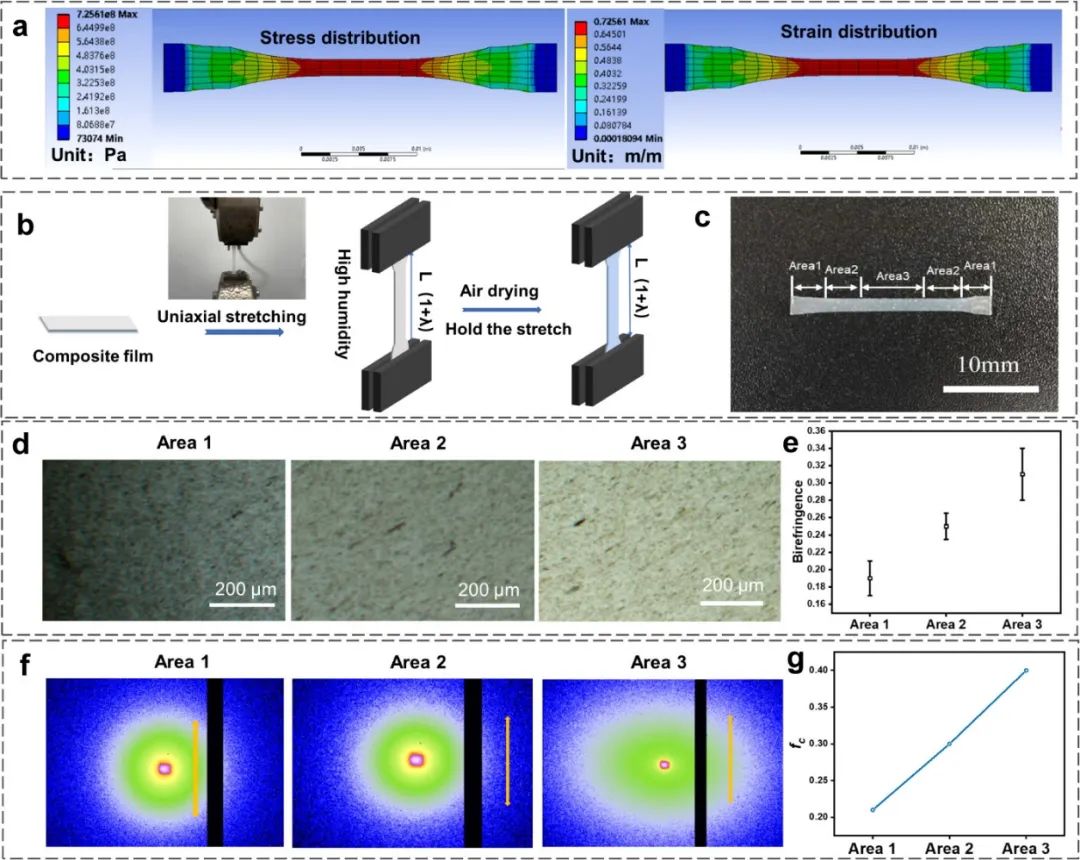The heterogeneity of bone is crucial for adapting to local strain environments, which is essential for maintaining mechanical function. This adaptation enables a strong correlation between strain distribution and multiple gradients, laying the foundation for creating complex gradient structures. However, the synthesis of such functionally graded materials has not been fully explored.
On October 19, 2024, a research paper titled “Multi-Gradient Bone-Like Nanocomposites Induced by Strain Distribution” was published online by Yang Ming’s team from Jilin University in ACS Nano. The study synthesized heterogeneous bone-like nanocomposites with complex structural and compositional gradients comparable to bone by inducing strain distribution within a polymer matrix containing amorphous calcium phosphate (ACP).
The uniaxial stretching of the composite film applies the maximum strain at the center, which gradually ceases towards the sides, resulting in a gradual decrease in polymer alignment and crystallinity. Meanwhile, due to the nano-confinement effect, the highly oriented center captures most of the ACP during stretching, thereby promoting the formation of a regular nanofiber structure. The edges, which experience the least strain, have minimal ACP, a characteristic of the porous structure. Due to template-induced crystallization, further crystallization of ACP generates oriented apatite nanorods in the center, with a crystallinity/amorphous ratio greater than minimal. The combination of structural and compositional gradients forms gradient mechanical properties, closely related to the span and amplitude of strain distribution. Due to the bone-like mechanical gradient, the center exhibits lower adhesion and self-healing capabilities compared to the edges, allowing for better recovery after complete severance. The strain distribution designed in this study is commonly present in load-bearing structures, representing a typical gradient biomimetic material.
 Heterogeneity is an inherent feature of biomaterials (such as exoskeletons, bones, cartilage, and teeth), often reflected through the coexistence of various gradient structures (including compositional and structural gradients). Inspired by natural gradient structures, various functionally graded materials (FGM) have evolved from rigid (metals and ceramics) to soft (polymers and their composites) components. The rapid development of soft FGMs in applications such as soft robotics, wearable electronics, and tissue engineering meets the demands of complex applications and has recently received widespread attention. Currently, methods for synthesizing soft FGMs include additive manufacturing, component redistribution, controlled phase transitions, and post-modification, while employing various external fields such as electric fields, magnetic fields, light fields, and centrifugal forces. Although dual gradient structures based on multiple compositional gradients can be achieved, these methods are only effective for generating one type of gradient at a time, and controlling both compositional and structural gradients presents a significant challenge in soft FGM design, often requiring sequential processing to combine these two characteristics.
Bone is a type of biological hard tissue whose chemical (the ratio of minerals to collagen and phosphates to carbonates) and structural (the arrangement of collagen) properties vary continuously. Unlike other biologically mineralized tissues (such as nacre and teeth), bone is a living material capable of adapting to mechanical environments. Mechanical strain stimulates bone formation, regeneration, and degradation processes due to stresses from muscle contractions, impact loads, and gravity. The ability of bone to respond to local strain ensures that gradient structures follow strain patterns, playing a crucial role in selective strengthening through increased mass and cross-sectional area. However, the potential biological mechanisms of mechanotransduction are particularly complex, often involving osteocytes. Osteocytes can sense external forces and activate osteoblasts by regulating calcium and sclerostin levels, thus promoting collagen mineralization. The final step involves the deposition of anisotropic apatite minerals, and extensive research has been conducted to gain a deeper understanding of the biomineralization mechanisms and structure-function relationships.
Heterogeneity is an inherent feature of biomaterials (such as exoskeletons, bones, cartilage, and teeth), often reflected through the coexistence of various gradient structures (including compositional and structural gradients). Inspired by natural gradient structures, various functionally graded materials (FGM) have evolved from rigid (metals and ceramics) to soft (polymers and their composites) components. The rapid development of soft FGMs in applications such as soft robotics, wearable electronics, and tissue engineering meets the demands of complex applications and has recently received widespread attention. Currently, methods for synthesizing soft FGMs include additive manufacturing, component redistribution, controlled phase transitions, and post-modification, while employing various external fields such as electric fields, magnetic fields, light fields, and centrifugal forces. Although dual gradient structures based on multiple compositional gradients can be achieved, these methods are only effective for generating one type of gradient at a time, and controlling both compositional and structural gradients presents a significant challenge in soft FGM design, often requiring sequential processing to combine these two characteristics.
Bone is a type of biological hard tissue whose chemical (the ratio of minerals to collagen and phosphates to carbonates) and structural (the arrangement of collagen) properties vary continuously. Unlike other biologically mineralized tissues (such as nacre and teeth), bone is a living material capable of adapting to mechanical environments. Mechanical strain stimulates bone formation, regeneration, and degradation processes due to stresses from muscle contractions, impact loads, and gravity. The ability of bone to respond to local strain ensures that gradient structures follow strain patterns, playing a crucial role in selective strengthening through increased mass and cross-sectional area. However, the potential biological mechanisms of mechanotransduction are particularly complex, often involving osteocytes. Osteocytes can sense external forces and activate osteoblasts by regulating calcium and sclerostin levels, thus promoting collagen mineralization. The final step involves the deposition of anisotropic apatite minerals, and extensive research has been conducted to gain a deeper understanding of the biomineralization mechanisms and structure-function relationships.
 Figure 1 Characterization of Heterogeneous Bone-Like Nanocomposites (Excerpt from ACS Nano)
Inspired by the mechanical properties of bones and their mineralization processes, there is increasing interest in synthesizing bone-like materials using collagen or cellulose, with nanofibers as templates. Hydrogels serve as scaffolds for apatite deposition and are also potential bone substitutes and repair materials, combining high hardness and high toughness. However, unlike bone, these materials do not possess complex gradients. On the other hand, piezoelectric polymers that generate surface charges under deformation can simulate mechanical stimulation for mineralization. Although this system can induce gradient mineralization, minerals only form on the surface of poly(vinylidene fluoride), and the resulting materials lack the structural characteristics of biological hard tissues.
Inspired by the strain-mediated gradients in bone, the authors utilized uniaxial stretching to create strain distribution within a polyvinyl alcohol (PVA) network infused with amorphous calcium phosphate (ACP) nanoparticles, which are important mineral precursors for bone mineralization. The strain distribution simultaneously generates chemical and structural gradients, further controlling ACP crystallization, resulting in a gradient of crystallinity/amorphous ratio. The complex gradient structure in bone-like nanocomposites leads to gradient mechanical properties closely related to strain distribution. Additionally, their adhesion and self-healing properties are also position-dependent, making them promising multifunctional biomedical materials.
https://pubs.acs.org/doi/10.1021/acsnano.4c08442
Figure 1 Characterization of Heterogeneous Bone-Like Nanocomposites (Excerpt from ACS Nano)
Inspired by the mechanical properties of bones and their mineralization processes, there is increasing interest in synthesizing bone-like materials using collagen or cellulose, with nanofibers as templates. Hydrogels serve as scaffolds for apatite deposition and are also potential bone substitutes and repair materials, combining high hardness and high toughness. However, unlike bone, these materials do not possess complex gradients. On the other hand, piezoelectric polymers that generate surface charges under deformation can simulate mechanical stimulation for mineralization. Although this system can induce gradient mineralization, minerals only form on the surface of poly(vinylidene fluoride), and the resulting materials lack the structural characteristics of biological hard tissues.
Inspired by the strain-mediated gradients in bone, the authors utilized uniaxial stretching to create strain distribution within a polyvinyl alcohol (PVA) network infused with amorphous calcium phosphate (ACP) nanoparticles, which are important mineral precursors for bone mineralization. The strain distribution simultaneously generates chemical and structural gradients, further controlling ACP crystallization, resulting in a gradient of crystallinity/amorphous ratio. The complex gradient structure in bone-like nanocomposites leads to gradient mechanical properties closely related to strain distribution. Additionally, their adhesion and self-healing properties are also position-dependent, making them promising multifunctional biomedical materials.
https://pubs.acs.org/doi/10.1021/acsnano.4c08442

—END—
The content is original from [iNature],
Reproduction must indicate the source from [iNature]
Add WeChat Group
iNature brings together 40,000 researchers and doctors in life sciences. We have formed 80 comprehensive groups (16 PI groups and 64 doctoral groups), and also established specialized groups related to specific fields (plants, immunology, cells, microbiology, gene editing, neuroscience, chemistry, physics, cardiovascular, oncology, etc.).Note: Please indicate when joining the group (format: school + major + name; if you are a PI/professor, please indicate you are a PI/professor, otherwise, it will be assumed you are a doctoral student, thank you).You can first add the editor’s WeChat ID (love_iNature), or long-press the QR code to add the editor, and then join the relevant group, serious inquiries only.


For submission, collaboration, and reprint authorization inquiries
Please contact WeChat ID:13701829856 or email:[email protected]
If you find this article appealing, please click here!




